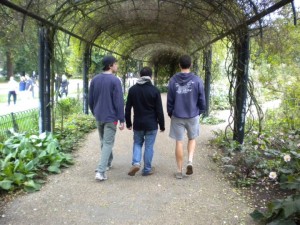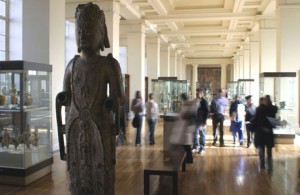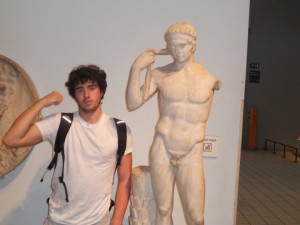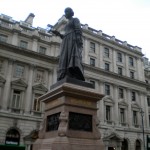Entries Tagged as '2010 MatthewG'
September 21st, 2010 · 1 Comment
Seeing churches is an incredible way to see into the past. Why, I asked myself, are there so many hundreds of year old churches still standing in England? Sure there are old buildings standing all over the place, but a vast majority of them are churches. After a little bit of thinking I’ve come up with a few reasons as to why I think very old churches had a better chance of surviving then they did in other places.
Since its founding, England has been one form of Christian or another. Already, this makes the survival rate of churches much higher then a place like Spain or Turkey, two regions since early times has switched hands from Christian to Muslim and perhaps back again. This great decreases the amount of churches destroyed or converted to mosques. This also means that while Edward I exiled the Jews from England in 1290 and their places of worship were probably destroyed and converted, there would be no reason in the history of England to tear down a church.
As we saw in Westminster, most churches had fortified sections in which to store the vast amounts of wealth that were being collected from the surrounding areas. This initiative to make sure churches could withstand attack could contribute to the stability of these structures. This may not be the same way in other parts of the world where vicious Vikings were not raiding the coasts.
These churches also serve as monuments to who, at any given point in history, were worthy of being commemorated in elaborate monuments within these churches. While well known now, we can see by his burial placement that Sir Christopher Wren did not quite have the status or celebrity that victorious military commanders held. The placement of these tombs and varying degrees of fanciness are a window into what was important to the empire in the past.
Tags: 2010 MatthewG · Churches and Cathedrals
September 20th, 2010 · No Comments
London has been a city inspiring to writers in every era since it was a Roman colony. I was hoping I would experience this side of London, the London of Chaucer, Dickens, and Jack London, who was an American writer inspired by both the grace and grit of London’s streets. I was not disappointed. Here are three unedited poems I have written so far in London.
The first poem was clearly written after our trip to the Proms at Royal Albert Hall. I was struck by the interaction between the audience and the musicians, something pretty much unseen at classical concerts in the US.
Concert Night
On a summer’s eve in Albert Hall
The second trumpet player slowly grew a beard
The cellos moaned a melody of courtly love
Somewhere in the balcony a woman coughed
The children felt sleepy
A flute missed a note
And in the background the bass drum
Sat quietly
Waiting to release
Its
Potential.
The next poem is a little rougher. It was based off an exhibit I saw at the Tate Modern and heavily influenced by the massive amount of theatre I have seen in the past few weeks. The instillation I am refereeing to was a big ruffled red theatre curtain that was closed and would never open. It was interesting, especially when juxtaposed to the lively theatre community in London. This one does not have a title yet.
What is behind the curtain that will never rise
In the theatre of what-will-be?
Maybe there is already a play of sorts
Running in the darkness behind the thick velvet curtain
And we will see nothing but this thick velvet curtain
And wonder if you can ever truly lay with beauty
But not realize that
The world is a stage and beauty is a motif of love
And all the while behind the curtain
(that is the opposite of transparent )
The silence goes unbroken
And the audience listens to make sure
That the only little soliloquy barely being breathed
Was inside themselves
The last poem is the ubiquitous East End during the Victorian era poem. I was especially interested by the church that until recently was the center of drug addiction in the area. The allusion to the church in the poem is based on that one. Also talking with some members of the Jack the Ripper tour group about the history and looks of that area helped me to write this.
Visions of White Chapel
All covered with shit and spit and stale beer
Whose alleyways were filled with misery and decay
Where even the churches hunch and cower
To keep their bells below the skyline
And there is no place like London
Where the underground ends and the streets
Lay barren below fog and soot
And here are the seamen, drunk on rum
Here are the cock-sure wretches of night
Here are the ladies with thighs so red
Here are the hopes of London
Poured with relish
Into the
Street
Cheers!
Tags: 2010 MatthewG
September 20th, 2010 · 5 Comments
I first noticed it one of our first walking tours. We were walking around Bloomsbury when we approached Bedford Square. It was a welcome patch of green and seemed reassuring and welcoming even from our first day in London, but on this day we actually tried to enter the small park. “Well it looks as if the Duke has decided to close the park today,” said Professor Qualls, his voice harboring a tone of disappointment. It was this moment that an idea dawned on me, public spaces in London aren’t truly “public,” they are mercifully given to the people by the aristocracy to brighten up their gloomy lives. For this reason, if the Duke of Bedford would like to have a personal picnic, or the Queen wants a day by the pond, they can close down any park they’d like for their own personal enjoyment.
This fact makes me a little perturbed. What is public space? That is one of the appealing things of Central Park in NYC, it is run by the publicly elected parks department officials. In that way the people decide who runs their parks. This is not the case in London.
The ownership of the “public” space is just another example of the feudal concepts of land ownership that still exist in England today. Just like the museums however, it seems to be the price one pays for perfectly manicured sports fields and classical European gardens that are open to the public. I am of course, talking about one of my favorite parks, Regent’s Park which I was able to return to a few times in pursuit of different things.
When it comes to parks in London however, the crown jewel (pun intended) is of course Hyde Park. It would take days of exploring to uncover all of the hidden landmarks and monuments.
So despite what you might think about the illusion of public space in a Monarchical space, these parks a a great place for a stroll on a sunny British day.

(personal photo)
Tags: 2010 MatthewG
September 18th, 2010 · 1 Comment
Theatre in England is a casual affair. In the United States, a night at the theatre is a formal event full of dressing up and champagne, a night a kin to going to a highbrow gala if you will. To some extent in England theatre is a reason to look nice, but it is not the event it is the United States. This is apparent by the five plays I have had the pleasure of seeing in the short time I have been in London.
“How plays in a month?” You may be asking, “How can he/the program possibly afford such a feat.” There in lies the casual atmosphere of the theatre. Tickets can be acquired relatively cheaply, I myself was able to procure box seats for Arthur Miller’s All My Sons a few nights ago for only 10 pounds and a few less hours of sleep.

Perhaps it is because being on Broadway just costs more for the production and therefore for the viewers, but the lower costs of London’s theatre scene allows both the viewers and the audiences to try something new. People, even on our program, are much more inclined to go see something they wouldn’t normally because it is only 10 pounds and not an outstanding 50-dollar balcony ticket like in the United States.
The lower costs also allow for more experimental theatre. Plays have the privilege to try things that the audience may not like because there is not as much of a monetary responsibility to the theatre. In the United States, a show will not be put on Broadway unless someone decides it can make money, and if it can make money it will go on an absurd 10 year run. With all of the heavy hitting Broadway shows that have been around for decades taking up the theatres, it leaves very little open space for the new, risky, and innovative.
I’m not saying entirely that theatre on Broadway has become stagnant and purely a moneymaking business, but I am saying that mostly. Off-Broadway is still a place in New York where one can see a risky new show, like this summers hit Bloody Bloody Andrew Jackson which I had the great honor of seeing in early July. To me though, it’s not about the surprising hit that emerges from the risky new theatre, its about the bombs. What shows you about London’s theatre scene are the flops, the things you see in Timeout magainze with only one star and a skull and cross bones warning you not to see the show.
Seeing Bedlam at the Globe theatre was not one of my fondest memories of London but the fact that a show of that caliber, written by novice playwright, could make it to one of London’s most iconic theatres without fear of a monetary disaster is inspiring and gives me hope for theatre to come.
Tags: 2010 MatthewG · Theatre
September 9th, 2010 · 2 Comments
The British Museum is probably the best place in the world to get a historical narrative of the collective human race. This is probably because at the end of the 18th century when the museum was founded, the British Empire was at its peak and the government wanted to show its citizens items from the mysterious and exotic reaches of the empire. So throughout the century items from all over the world were shipped to London.
We can still see all of those items there today, and I have already spent many many hours exploring the museum’s diverse and extensive collection. I really enjoy the opportunity to listen to the podcasts (the history of the world in 100 items) on my journey through the museum. It was while listening to the podcast today about the Chinese Han Lacquer Cup that I began to notice something. Although the podcast references the items role in its specific country of origin, its primary goal is to show the listener where the piece fits in the history of the human race, as most items represent an idea or new technological skill.
This is a very globalizing force because all of the objects, whether Greek, Chinese, or Roman, are discussed in a way that illustrates them as items of human creation rather then objects of any specific empire or nation. In fact the museum tends to make the pieces culturally neutral as well by making most rooms look exactly the same. Each room has a glass case on each wall with perpendicular glass cases jutting out into the center of the room. In the middle occasionally there will be a larger item of more significance. As an avid attendee of American museums, I am spoiled by the Metropolitan Museum’s ability to change the layout and design of each room depending on what culture is on display.

Perhaps this monotonous layout is designed to do what the podcast also attempts to do, make it one universal history unified in the museum by carbon copied rooms. This then gets to the debate brought up all over the world of whether or not those items even belong in the British Museum, but that is entirely too much to discuss in one blog.

Tags: 2010 MatthewG · Museums
For the majority of human civilization history has been recorded by and about men. Today we learned that portraits are just another form of history telling. In the patriarchal society that has emerged in Europe in the past few centuries, powerful men have had their likenesses recorded by painters and photographers alike. The artists, who too were white men for the most part, helped to record a history in paintings that has sent the message that in any given era, white men were the only people worthy of remembrance.
Not all of these men illustrated however, were men that were famous or powerful. One portrait that drew my attention, John Ballantyne’s The Artist’s Studio depicts a man, small and off center, carving the lions that would one day sit in London’s Trafalgar Square. It took a little researching but I finally found the picture to be painted of Sir Edwin Henry Landseer, someone whose name I was not familiar with but whose work I had seen dozens of times either on television or on the street. Even in the photo, this man is in the shadow of these monstrous lions, symbols of the aristocracy. It was interesting to finally get another perspective on the monuments all over London. All of these monuments honor great men, but behind all of them were unknown artists commissioned to sculpt or paint for little or no recognition or acclaim.

(photo from http://www.nnf10.org.uk/programme/detail/The_Artists_Studio)
Although the gallery was filled mostly with white rich men, it was refreshing to see this one painting of an almost normal guy who, like everyone else, was a subject and servant to an immutable class system.
Tags: 2010 MatthewG · Museums
September 2nd, 2010 · 4 Comments
In England, I have discovered beer to be an appropriate beverage for any time, place, or person. It can be a drink of the everyman and a drink of the aristocrat, a refreshing drink for the conservative manual worker or the Avant-garde intellectual. In my first week in London, I have had beer in so many different contexts that I am now convinced of this fact.
At the Notting Hill Carnival, London’s yearly Afro-Caribbean festival, Red Stripe (a popular Jamaican beer) was the name of the game. Jamaica, similar to former British colonies across the Caribbean, contributed a lot to British culture, including its own style of Britain’s favorite beverage. It seems that where the British once had power, breweries became an essential craft. In this way, the exportation of beer and the making of international beer culture appears to have colonialism to thank.
Colonialism wasn’t that only “ism” that beer has exposed me to this week. The British Museum, one of the world’s most important cultural institutions, has been a place of study for intellectuals since its creation at the end of the 18th century. When these intellectuals were not studying however, I have read that many of them would go across the street from the museum to the Museum Tavern for a pint. After a few intellectually stimulating hours in the museum, we made our way across the street to the tavern. The décor was similar to all other pubs we had visited but this one seemed a bit more authentically 19th century. This feeling was only enhanced by a pint of very delicious ale called “Old Peculiar.” What really struck me about the drinking in this particular pub was knowing that somewhere in that very room Lenin and Trotsky had sat and contemplated ways to liberate the peasants of Russia, or that Marx had sat with a pint after the long days spent writing Das Kapital across the street. Just as beer played a part in British imperialism, so too was beer present in the forefront of intellectualism in Britain.
Classism is also a British cultural topic demonstrated by beer. As iterated by Kate Fox in her book, Watching the English, your choice of beer/beverage can say a lot about a person’s social class. The bartenders and the English people in the pub expect certain people to buy certain drinks and my choice of beer could break unwritten social rules and earn me a liberal amount of strange looks. I have seen this first hand when ordering a half pint of cider (to protect my standing in British society, I must add that this was done for a lady).
Imperialism, Intellectualism, and Classism. All three of these British “isms” are cultural concepts that are literally seeped in beer.

Tags: 2010 MatthewG · Pubs · Uncategorized
Today we were assigned to explore the Camden Street Market and the Stable Market. Four stops north of Goodge station we emerged into a neighborhood where London’s infamous punk culture is still thriving. Head shops, tattoo parlors, and jazz and rock bars lined the street as we made our way to the Camden Street Market. Residing in an empty lot designated for the market, the rows of tents provided the eager shoppers with clothing. After only a few minutes the group realized that most of the stands, which were run mostly by Southern and Eastern Asian immigrants, were hocking the same articles of clothing. Cheaply made summer dresses, sweaters, and tee shirts sporting ironic sayings and American pop culture icons were only a few of the items that we passed over and over again as we looked through all of the different tents. Although most of the garments did not have price tags on them, the proprietors were quick to offer “great” deals to us, which would become even “greater” deals after we had begun to walk away.
After emerging from the Camden Street Market we searched the neighborhood for the Stable Market. After around 30 minutes of searching (passing pubs with such colorful names as, “The Elephants Head,” “The Spread Eagle,” or my personal favorite “The World’s End”) we finally stumbled upon a crowd of people looking over the edge of a bridge. As we looked over ourselves to see what all of the fuss was, and soon uncovered the Camden Lock Market, and the Stable Market beyond it. These made up a sprawling market that seemed to run for miles. In the Camden Street Market, the shop keepers were mostly English citizens who made their living selling among other things, hand made crafts, art, clothing, and antiques. The shops at the center of Stable Market are housed in the dozens of old stables where over 250 of London’s horses were housed in the centuries before the automotive revolution. The market boasted as much diversity in its food as it did in its vast variety of vintage clothing. The mass of stalls prepared food from every continent (including Antarctica whose population of penguins eat mostly raw fish), which was perhaps, a vague reminder of the worldwide empire that was once ruled from London, as well as a sign of the how multicultural the city has become. After three hours of adventuring through the market we were unable to see all of it’s shops or follow every vein of the market. Some highlights we saw were a spontaneous drum circle that had sprouted in the middle of an African drum store, a stall that offered foot messages to customers by having them soak their feet in a tank filled with fish, and cup cakes so small and well decorated that they would have put anything on the food network to shame. After a quick meal by the little river that snaked through the neighborhood, we gathered the bounty of dresses and skirts the girls of the group had acquired and regretfully said goodbye to the market, vowing to return again.
For more information see http://www.stablesmarket.com/
And for Time Out’s guide to the Camden Markets see http://admin.timeout.com/london/shopping/features/8798/Camden_Market_guide.html
Tags: 2010 Emily · 2010 Kaitlin · 2010 MatthewG · Uncategorized
August 26th, 2010 · 1 Comment
Professor Qualls assigned us Piccadilly Circle. The hardest part was figuring out what Tube station to start from – we didn’t know what was the closest to the Arran Hotel, so that took a little bit of aimless walking around Tottenham Court Road (not that we’ce complaining). It was the Goodge Street station we were after, and we think that being able to find it will be useful before long.
Matt spent the summer in New York City, and Mary Kate has used the New York subway on occasion, and neither of us has ever seen anything quite like the Tube. Its walls are plastered in colorful ceramic tile – untainted by graffiti – and the advertisements lining the walls of the railway promote opera and theater. In speaking of opera, the performers trying to make money in the subway seem to have a different repertoire here: we heard an opera singer and soft-rocker on a keyboard in our stations today. The Goodge Street station also featured a winding staircase of 136 stairs – we were surprised when we expected to run down two flights as a quicker alternative to the lift.
We took Goodge to Tottenham Court Rd, and from there we transferred to the Piccadilly Line at Leicester (pronounced “Lester”?) Square. None of our rides on the Tube were longer than 90 seconds, and every time we found our platform, the Tube train was already waiting for us. (The instant train access was another thing we weren’t used to from American subway systems.) When we climbed out of the Piccadilly Station, named for the Piccadilly Circus, and into the City of Westminster, we felt a world away from Gower Street. “This is the Times Square of London,” Matt immediately remarked. Flashing lightbulbs, MacDonald’s advertisements (and stores), punk rockers with orange spiked hair posing for pictures (for a few quid), and plenty of traffic made us feel more like we were in an American city than we have felt yet. The architecture of the buildings , though– on the second level, above the franchise coffee shops and tourist-y clothing stores – reminded us we were in London: regal brick and stone with ornate facades, often topped with statues or domes lined the streets in all directions. Several tourists asked us to take their pictures in front of statues, and we spotted a few posing outlandishly in front of fountains.
Our favorite memorial statue in Piccadilly Circus was a little further away from the hustle and bustle surrounding the central fountains and monuments. We gravitated toward the Crimean War memorial. (Although it should be noted that actually getting across traffic to reach the memorial is much easier said than done.) It featured a statue of Florence Nightingale, where people continue to leave bouquets of flowers in her honor.
Getting back to the Arran House (even in our fog of jet lag), proved to be a snap. We took a different route – Piccadilly to Oxford Circus to Tottenham Ct. Rd. and a three-block walk home – and got to see a few pubs and store fronts we missed the first time around.
Tags: 2010 MaryKate · 2010 MatthewG








